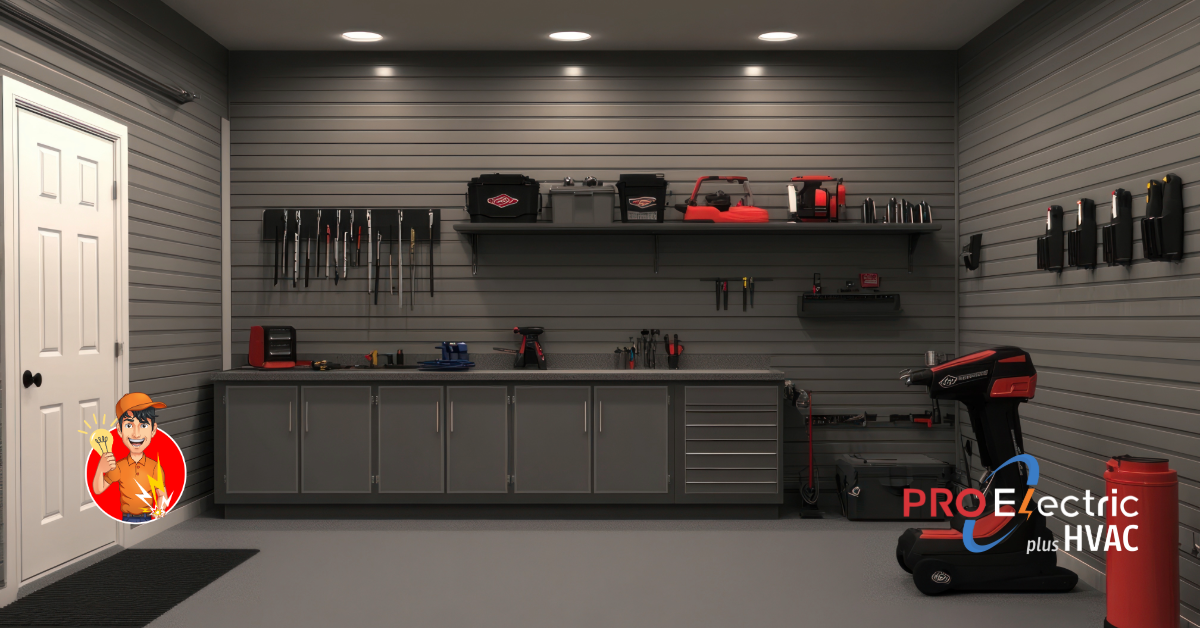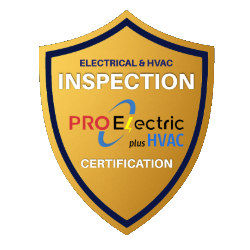By Peter, Master Electrician | PRO Electric plus HVAC | Electrical Panel Upgrades
Chantilly Basement Workshops & Space Heaters | Subpanel Overload Fixes
Hi, I’m Peter with PRO Electric plus HVAC.
I love a good basement workshop; saws humming, chargers blinking, projects coming to life.
But I see a common problem in Chantilly homes: the workshop circuit plan never kept up with the tools, and then winter arrives with space heaters.
The result?
A subpanel that runs hot, breakers that trip, lights that dip, and hidden heat at the outlets.
Let me show you why this happens, how to spot it early, and how to fix it correctly.
Why workshops and space heaters don’t play nice
- Big startup surges: Saws, planers, dust collectors, air compressors, and shop vacs can pull 2–3× their running current at start-up.
- Continuous heat load: A 1,500-watt space heater pulls about 12.5 amps on its own. Add a tool surge, and you’re past what a 15-amp circuit can handle.
- Shared circuits: Many basements are wired with general-purpose outlets on long runs. One heater + one big tool = instant trip or silent overheating if connections are loose.
- Subpanel squeeze: Tandem breakers, mixed loads, and poor balancing can make the bus run hot even when breakers don’t trip.
Early warning signs your subpanel is stressed
- Breakers trip when a heater and tool run together
- Lights flicker or dim when a saw starts
- Panel cover feels warm or buzzes
- Outlets or plugs feel hot after use; cords discolor
- You’re using multiple power strips to “fix” outlet shortages
- A heater works in one outlet but trips in another on the same wall
Safety note: Look, don’t touch. Don’t open a live panel if you’re not trained.
The 5-minute “eyes-only” workshop check
- Map what’s on what. Turn off one breaker and see which outlets go dead. If half the shop dies at once, too much is riding on that one circuit.
- Test a heater + one tool. If the lights dip or the breaker clicks, that’s a capacity clue.
- Feel the cover plates. Warm outlets mean loose connections or overload.
- Check cord lengths. Long, skinny extension cords act like heating elements.
- Peek at the subpanel label. If it’s filled with tandem (skinny) breakers or mixed brands, you’re likely out of safe space.
Smarter ways to heat a basement workshop
- Dedicated 20-amp circuit for a space heater (if you must use one), one heater per circuit, heavy-duty receptacle.
- Even better: install a wall-mounted electric unit heater on a dedicated circuit with proper mounting and clearances.
- Best comfort play: a small ductless heat pump (mini-split) dedicated to the shop—efficient heating in winter, cooling in summer, no outlet overload.
The right way to power tools
- Dedicated circuits for high-draw tools (table saw, compressor, dust collector).
- Consider 240-volt circuits for stationary tools designed for it—lower current, smoother starts, less voltage drop.
- Keep the dust collector and main saw on separate breakers so a cut doesn’t stall your dust control.
- Use 12-gauge wiring and 20-amp receptacles for general shop outlets where allowed; fewer shared loads, fewer trips.
Subpanel sanity: clean, balanced, and listed
When I service a Chantilly subpanel, I:
- Verify listing & breakers. Replace non-OEM breakers with listed ones.
- Balance the legs. Move heavy circuits to even out the load and reduce flicker.
- Retire tandems where not allowed and add real spaces (subpanel or upgrade).
- Torque and thermal scan. Tighten terminations; look for hot spots you can’t see.
- Label everything. Clear labeling prevents “mystery” overloads later.
Good / Better / Best upgrade paths
Good: Panel clean-up
-
Replace mismatched breakers, fix loose neutrals, add whole-home surge protection, and move heavy loads off shared circuits.
Better: Dedicated shop circuits + tidy subpanel
-
Add a subpanel with room to grow. Give the dust collector, saw, compressor, and heat source their own circuits.
Best: Capacity + comfort
-
200-amp service (if needed) + mini-split for year-round comfort + clearly labeled, balanced circuits. No juggling heaters and tools.
Quick do’s and don’ts
Do
- Use short, heavy-duty cords only when necessary
- Keep saw, dust collector, and heater on separate circuits
- Schedule EV charging or laundry outside shop hours on small services
Don’t
- Daisy-chain power strips
- Run a heater on a cord reel
- Hide warm or browned outlets behind benches—call me
A local note for Chantilly basements
Many townhomes and colonials here have finished basements turned into hobby shops.
I often see tandem breakers stuffed into small panels, plus one or two space heaters in winter.
It “works” until the first cold snap and project weekend line up.
The fix is usually a couple of dedicated circuits and a clean subpanel—not a fortune, and a huge safety win.
Final thought
Your workshop should make sawdust, not electrical heat.
If you’re juggling breakers, swapping outlets, or babying a space heater to keep tools running, your subpanel is telling you it’s time for a plan.
If you’re in Chantilly, call PRO Electric plus HVAC at 703-225-8222 and ask for Peter.
I’ll map your loads, clean up the subpanel, and give you smart, safe options—so your projects run smooth in every season.
📞 Call 703-225-822 now or book online while you’re thinking about it.



